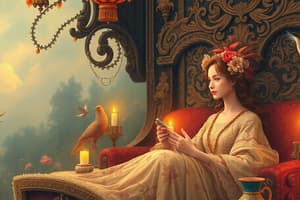Podcast
Questions and Answers
What is the main purpose of conflict in a story?
What is the main purpose of conflict in a story?
- To determine the plot structure
- To provide a realistic setting
- To give the characters something to overcome (correct)
- To introduce the characters
Which element of a story marks the end of the conflict?
Which element of a story marks the end of the conflict?
- Exposition
- Denouement (correct)
- Climax
- Rising Action
How does setting impact a story?
How does setting impact a story?
- By creating the plot structure
- By influencing the cultural norms and feel of the story (correct)
- By determining the characters' personalities
- By providing the conflict resolution
What is the primary role of main characters in a story?
What is the primary role of main characters in a story?
Which element of a story involves where and when the story takes place?
Which element of a story involves where and when the story takes place?
What is the purpose of the five basic elements of a story (setting, character, plot, conflict, and theme)?
What is the purpose of the five basic elements of a story (setting, character, plot, conflict, and theme)?
What is the least reliable point of view in storytelling?
What is the least reliable point of view in storytelling?
In the example provided, what is the setting of the murder mystery story?
In the example provided, what is the setting of the murder mystery story?
Which point of view treats the reader as a character in the story?
Which point of view treats the reader as a character in the story?
Which of the following best describes the role of the character in a story?
Which of the following best describes the role of the character in a story?
In which point of view does the narrator describe the thoughts and feelings of only one main character?
In which point of view does the narrator describe the thoughts and feelings of only one main character?
According to the example, what is the central conflict in the murder mystery story?
According to the example, what is the central conflict in the murder mystery story?
Which point of view is considered the most reliable because it provides information from all perspectives?
Which point of view is considered the most reliable because it provides information from all perspectives?
What is the theme established at the end of the murder mystery story example?
What is the theme established at the end of the murder mystery story example?
Which narrative element contributes heavily to the tone of a story?
Which narrative element contributes heavily to the tone of a story?
Flashcards are hidden until you start studying
Study Notes
Story Elements
- A story's setting determines its feel, possibilities for conflict, cultural, and social characteristics.
- Characters are the people, animals, or personified inanimate objects that experience the story and can even be used as a setting.
- Main characters drive the story, undergo significant development, and perform actions that allow the reader to have experiences through them.
Plot
- The plot is what happens as characters encounter and attempt to resolve conflict.
- Exposition is the beginning of the story where characters, setting, and conflict are established.
- Rising action follows the exposition, marks the point where main characters first encounter the conflict, and creates tension.
- Climax is the culminating point where characters must confront the conflict, resulting in an intense scene or verbal confrontation.
- Falling action is the direct result of the conflict, resulting in positive or negative consequences for the characters.
- Resolution marks the end of the conflict and the story's conclusion, sometimes explaining the final outcome for the characters.
Conflict
- Conflict is the problem or challenge that characters face and is necessary for a story.
- Conflict can be internal (a struggle between one character's competing desires) or external (e.g., facing a hurricane).
Theme
- The theme is the overall message or lesson that the reader gathers from the story.
- The author's purpose is to offer a certain insight, which is the theme of the story.
Advanced Elements
- Point of view is the perspective from which the story is told and can be 1st person, 2nd person, 3rd person limited, 3rd person omniscient, or 3rd person objective.
- Tone is the author's attitude toward the subject of the story, established through word choice and portrayal.
- Style is the way the author writes, contributing to tone through mechanical writing choices like syntax, diction, and figurative language.
Crafting a Story
- Authors make intentional choices to shape stories, including setting, character, plot, conflict, and theme.
- Changing one element can dramatically affect a story's structure and impact.
- Authors use narrative elements to create a story, building a message or observation about life through their choices.
Studying That Suits You
Use AI to generate personalized quizzes and flashcards to suit your learning preferences.




